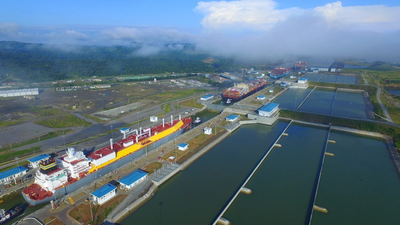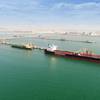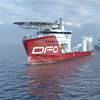Panama Canal Sets Record Annual Cargo Tonnage
According to figures, the Panama Canal transited a total of 13,548 vessels during its FY17, representing a 3.3 percent increase compared to totals the year before. Thanks to the larger Neopanamax vessels now able to transit the Expanded Canal, the growth in traffic translated into a 22.2 percent increase in total annual tonnage from FY16, and helped the Panama Canal surpass the already ambitious cargo projection of reaching 399 million PC/UMS.
“This year’s success is a testament to the Expanded Canal’s success,” said Panama Canal Administrator Jorge L. Quijano. “These record figures reflect not only the industry’s confidence in the Expanded Canal, but also illustrate the Panama Canal’s continued ability to transform the global economy and revitalize the maritime industry.”
Expanded Canal’s Performance During FY17
After setting similar records in December 2016 and May 2017, the Neopanamax containership CMA CGM Theodore Roosevelt became the largest ship to transit the Canal to date in August 2017, measuring 365.96 meters in length and 48.252 meters in beam with a Total TEU Allowance (TTA) of 14,863. The ship later traveled to the Port of New York and New Jersey for the inauguration of the raised Bayonne Bridge.
In September 2017, the Canal launched Panama’s Maritime Single Window (VUMPA), with other Panamanian bodies, to streamline logistics paperwork for international customers. To uphold sustainability efforts, the Canal created the Environmental Premium Ranking in October 2016 to reward qualified customers who meet high environmental efficiency standards with the opportunity to improve their position within the Customer Ranking System, which is taken into account when booking transits through the Canal. The Panama Canal also instituted modifications to the toll structure in response to a series of discussions with customers and a review of changing cargo patterns.
The Panama Canal currently serves 29 major liner services, including 15 Neopanamax liner services, primarily on the U.S. East Coast to Asia trade route.
Performance by Segment
The container segment continued to serve as the leading market segment of tonnage through the Canal, accounting for 35.3 percent of the total cargo received. This equated to a total 143 million tons PC/UMS, of which 89.1 million tons transited the Expanded Canal. Tankers – which include liquefied petroleum gas (LPG) and liquefied natural gas (LNG) carriers – represented the following market segment (105 million PC/UMS).
The next leading segments included bulk carriers (79 million PC/UMS) and vehicle carriers (47 million PC/UMS).
A Global Impact
Beyond Panama, the impact of the Canal was felt around the world.
In FY17, the main routes using the Panama Canal were between Asia and the U.S. East Coast (34 percent), the West Coast of South America and the U.S. East Coast (13 percent), the West Coast of South America and Europe (7 percent), the West Coast of Central America and the U.S. East Coast (7 percent) and intercoastal South America (5 percent).
The countries of China, Chile, Japan, Mexico and Colombia were some of the top users of the Panama Canal, while the United States continued to be the main user of the waterway representing the origin or destination for 68.3 percent of the total cargo transiting the Canal.
The impact of the Expanded Panama Canal was also apparent in many ports along the U.S. East Coast, which were able to welcome the larger Neopanamax ships from the Canal and saw increased growth. Some even set records in terms of their year-on-year growth and the total amount of tonnage received – all of which can be directly attributed to the widening of the Panama Canal.
Other ports recently completed, or are continuing to advance, a number of infrastructure projects that allow them to receive Neopanamax ships, as well.
Positioning the Canal for the Future
As the shipping industry continues to adapt to the Expanded Canal, the Panama Canal is working to bolster the capabilities of the waterway through various infrastructure projects aimed at providing greater connectivity and transshipment opportunities to the region. Specifically, the Panama Canal maintains plans to concession a roll-on roll-off (RoRo) terminal to serve as a center for the redistribution of vehicles, machinery and heavy equipment and a 1,200-hectares logistics park to further strengthen the logistics services in the region, among other projects.
The 2017 Fiscal Year began on October 1, 2016, and ended on September 30, 2017.













